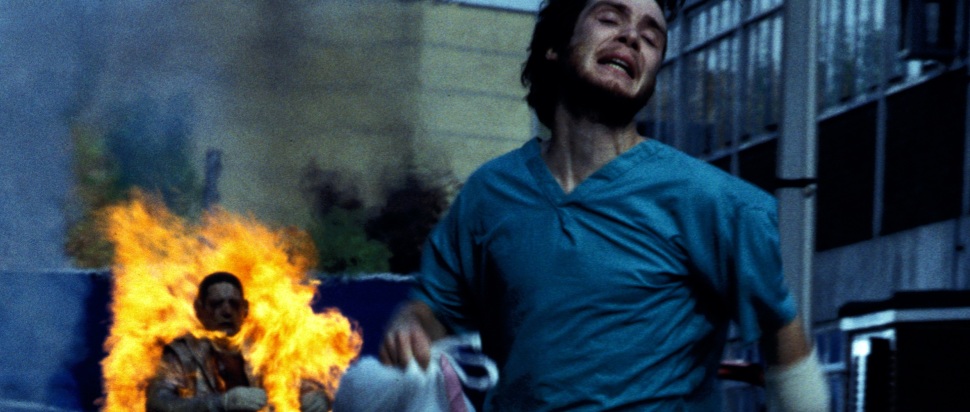28 Days Later, 20 Years Later
Remember in the early 2010s when every other film and TV show on our screens seemed to be about zombies? You probably have the popularity of Danny Boyle's 28 Days Later to thank. Two decades after its release, we look back at this horror masterpiece
It’s 2023, and zombies are still very much on our screens, even if this year’s biggest undead hit – The Last of Us – never uttered the Z-word. The peak of the most recent zombie craze was in the early 2010s. The Walking Dead was rising on TV; movies ranged from zombie romance Warm Bodies to zombie epic World War Z; and alongside The Last of Us, Call of Duty was getting in on the zombie action on the video game side. The Last of Us aside, the trend does seem to be dying down significantly, though, making way for the more self-serious ‘elevated’ horror. But one zombie film – one of the first films to help kick start this cycle – has endured like no other even two decades on.
In retrospect, it’s clear that 28 Days Later wasn’t just a great horror-thriller; it was genuinely ahead of its time (and not just in predicting an empty Britain in the wake of a pandemic). In addition to helping kick off one of the biggest pop culture moments of the following decade – as much as director Danny Boyle claims that the film's antagonists aren’t true zombies – the film was a breakthrough for many of its then-unknown actors, who have since become bonafide stars. The most obvious example is Cillian Murphy, who at this point was utilising a gentle Irish charm rather than the brooding intensity he became known for thanks to Peaky Blinders, Batman Begins, and the upcoming Oppenheimer. However, you can’t overlook a pre-Pirates of the Caribbean Naomie Harris, playfully intimidating as relentless survivor Selena, and Christopher Eccleston, who was yet to begin his stint as the best Doctor Who.
These actors are now known across the globe, but one of the main strengths of 28 Days Later – especially when compared to the later onslaught of American zombie content – is its national specificity. Though its 2003 release has led some to associate it with a wave of 9/11-influenced mainstream films that were united in their darker themes and emphasis on realism (such as War of the Worlds, Cloverfield andThe Dark Knight trilogy), I’d argue it more closely aligns with the British cinematic history of grit and social realism, particularly given Boyle’s earlier work on Trainspotting and Shallow Grave. (Also, much of 28 Days Later's filming was completed prior to the attacks).
Though its debt to British cinema traditions is present on a thematic level, this specificity goes even further in the narrative thanks to a conclusion that could only truly occur in the UK: the rest of the world has left us to rot on our island while they carry on with their lives. While many prefer the original, much darker ending that sees Murphy's character, Jim, dying in hospital while the two female leads face an uncertain future, the theatrical ending ultimately delivers an optimistically subdued reflection on Britain’s place in the global sphere – we aren’t the centre of the Earth anymore, and that’s almost definitely for the best.
This concept is essentially undone in the non-Boyle follow-up 28 Weeks Later, which depicts the intervention of the US army and (spoilers) the eventual spread of the Rage virus to continental Europe, but as a standalone film, the original is a surprisingly poignant exercise in post-colonial cinema.
Another stand-out component of 28 Days Later when contrasted with other films in the zombie subgenre is its fantastic score from John Murphy, as unique and unsettling as Goblin's soundtrack for Dawn of the Dead 25 years prior. Though tense and gripping throughout, his work undoubtedly reaches a peak during the climax of the film, in which Jim goes on a rampage so violent it becomes unclear if he’s truly still human. The music at this point in the film relentlessly pounds as Boyle cuts quickly between violent vignettes of the infested country estate, never resolving its ever-rising pitch and discordant melody. Other zombie films may be scarier, but none match this level of unbearable intensity.
And all of this is without even directly saying what a well-constructed, compelling film Boyle created. Perhaps the high-water mark of his filmography, 28 Days Later is a zombie movie like no other, especially in a sea of American films that, while sporadically interesting, often blend together in a wave of celebrity cameos and CGI gore. Boyle’s creation, by respecting its roots, is a true original, and is just as tense and invigorating to experience as the zombie craze dies down as it was at its inception.
